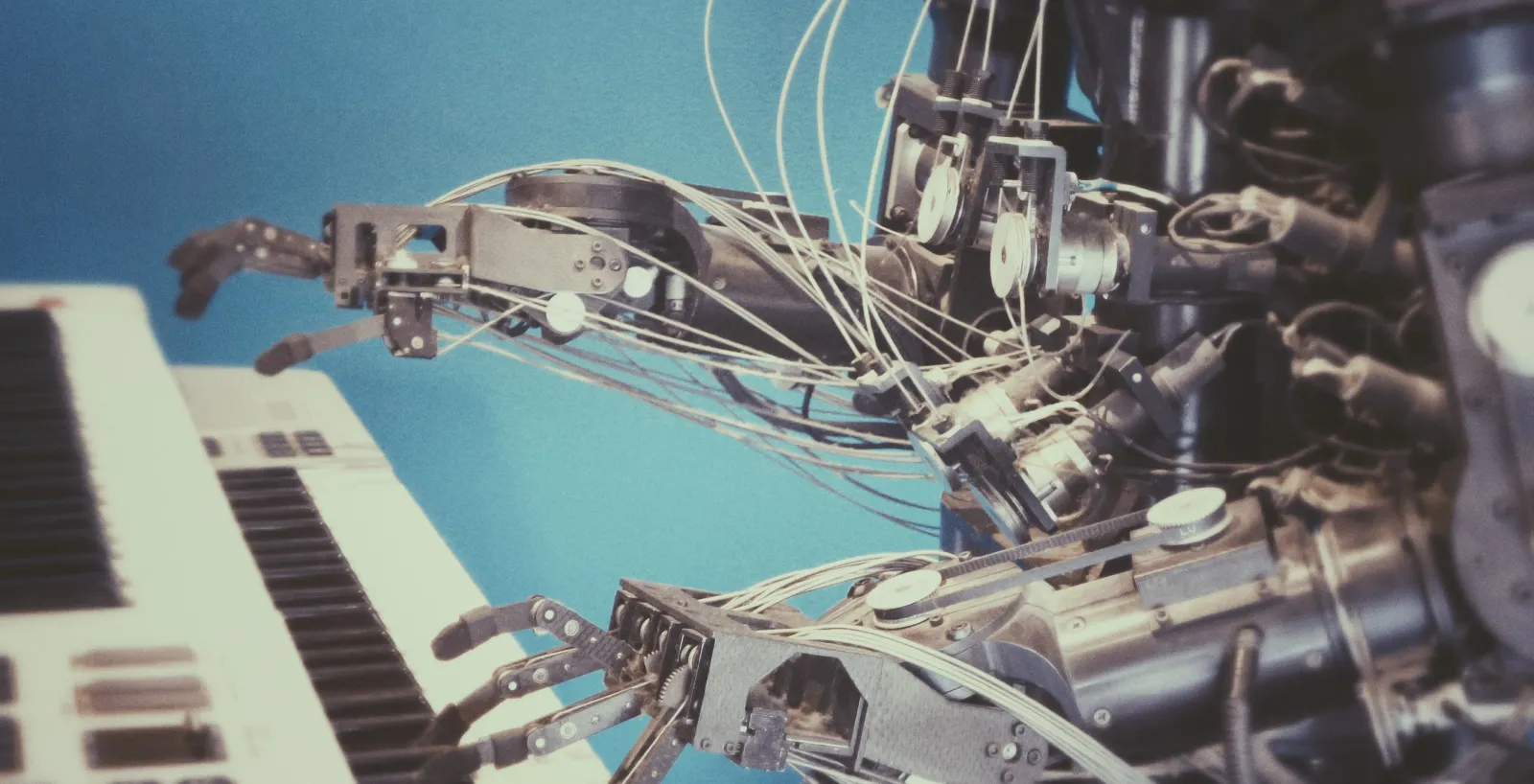
Maria Chojnowska
12 May 2023, 10 min read

What's inside
- Key Differences between Machine Learning and Deep Learning
- Advantages and Disadvantages of Machine Learning and Deep Learning
- When to Use Machine Learning vs. Deep Learning
- Overview of popular ML and DL frameworks and libraries
- Conclusion
- Contact us
Machine Learning (ML) is a subset of Artificial Intelligence (AI) that uses statistical algorithms and models to improve computer systems' performance on a specific task by learning from data without being explicitly programmed.
Deep Learning (DL) is a subfield of Machine Learning that involves using neural networks with multiple layers to learn from large amounts of data and perform tasks such as image recognition, natural language processing, and speech recognition. The structure and function of the human brain inspire DL.
Machine Learning (ML) and Deep Learning (DL) are two different subsets of artificial intelligence (AI) that have unique characteristics, capabilities, and limitations. Understanding the differences between ML and DL is crucial because it can help individuals and organizations determine which approach best suits their needs.
Key Differences between Machine Learning and Deep Learning
Architecture
- ML algorithms are based on traditional statistical models.
- DL algorithms use artificial neural networks with multiple layers of interconnected nodes.
This architecture allows DL models to learn more complex patterns in data, making them more powerful and accurate than ML models.
Data requirements
- ML algorithms can be trained on small to medium-sized datasets.
- DL algorithms require large amounts of data to train effectively. DL models are designed to learn from complex and unstructured data.
Feature Engineering
- ML requires manual feature engineering to extract relevant features from the data.
- DL models can automatically extract relevant features from the data, which reduces the need for manual feature engineering.
Performance
- DL algorithms outperform ML algorithms in tasks that involve complex data patterns. However, they require more computational power and are more complex to implement and interpret.
Interpretability
- ML models are based on more traditional statistical models, making them easier to interpret.
- DL models are made up of multiple layers of interconnected nodes, making it difficult to interpret the relationship between the input and output.
ML models are generally more interpretable than DL models.
Application scope
- ML algorithms are well-suited for predictive modeling, clustering, and classification tasks.
- DL algorithms are more suitable for image and speech recognition, natural language processing, and robotics tasks.
Advantages and Disadvantages of Machine Learning and Deep Learning
Pros of ML
- Automated Decision-Making: ML allows machines to make decisions automatically based on the data provided, which can help organizations save time and money on decision-making processes.
- Scalability: ML models can be trained on large amounts of data, which makes them highly scalable and capable of handling large datasets.
- Increased Accuracy: ML models can improve their accuracy over time as they learn from data. This makes them highly accurate for tasks such as image recognition, speech recognition, and natural language processing.
- Cost Savings: ML can help organizations save costs by automating repetitive tasks, reducing the need for human intervention, and improving process efficiency.
- Improved Customer Experience: ML can analyze customer data and provide personalized recommendations or customer service, improving the overall customer experience.
Cons of ML
- Data Requirements: ML models require large amounts of data to be trained effectively. This can be a challenge for organizations with limited data resources.
- Complexity: Developing and deploying ML models can require advanced technical skills, making it difficult for some organizations to implement.
- Bias: ML models can be biased if trained on biased data or if the algorithm is biased. This can result in unfair outcomes or inaccurate predictions.
- Interpretability: Some ML models can be difficult to interpret, making it challenging to understand how the model arrived at its predictions or decisions.
- Lack of Context: ML models lack contextual understanding, which can result in incorrect predictions or decisions if the model lacks enough context.
Pros of DL
- Improved Accuracy: DL models can achieve high accuracy levels, especially in complex tasks such as image and speech recognition, natural language processing, and robotics.
- Automated Feature Extraction: DL models can automatically extract relevant features from the data, reducing the need for manual feature engineering.
- Large-Scale Data Processing: DL models can handle large amounts of data, making them well-suited for tasks such as big data analysis, machine vision, and natural language processing.
- High Performance: DL models can be trained on parallel processing hardware such as Graphics Processing Units (GPUs), resulting in faster training times and higher performance.
- Versatility: DL models can be applied to various applications, from image and speech recognition to autonomous driving and medical diagnosis.
Cons of DL
- Data Requirements: DL models require large amounts of data to be trained effectively. This can be a challenge for organizations with limited data resources.
- Hardware Requirements: DL models require high computational power and specialized hardware, such as GPUs, which can be expensive and need technical expertise.
- Black Box Nature: DL models can be difficult to interpret. They involve multiple layers of interconnected nodes, making it challenging to understand how the model arrived at its predictions or decisions challenging.
- Overfitting: DL models can overfit the training data, resulting in poor performance on new, unseen data.
- Lack of Robustness: DL models can be sensitive to small changes in the input data, making them less robust to noisy or incomplete data.
When to Use Machine Learning vs. Deep Learning
You may wonder, then, when to use ML and when to use DL. The choice between machine learning (ML) and deep learning (DL) depends on several factors, such as the task requirements, the available data, and the computational resources.
Factors to consider when choosing between one and another:
- Task Complexity
ML is a good choice for simple classification or regression problems. At the same time, DL is better suited for complex tasks such as image and speech recognition, natural language processing, and robotics.
- Data Availability
ML can be used for tasks with smaller datasets, while DL requires larger amounts of data to be trained effectively. If you have limited data, ML may be a better choice.
- Feature Engineering
If the relevant features are well-known and can be identified and selected manually, ML may be a better choice. DL is better if the features are complex and challenging to identify.
- Hardware Resources
DL requires high computational power and specialized hardware, such as GPUs, which can be expensive and require technical expertise. If you have limited hardware resources, ML may be a better choice.
- Interpretability
ML may be a better choice if interpretability is important, as it involves simpler algorithms and fewer layers than DL.
- Time Constraints
If time is a critical factor, ML may be a better choice if time is a critical factor, as it typically requires less time to train models than DL.
As you can see, ML is a more accessible and versatile approach, while DL is better suited for complex tasks that require processing large amounts of data. The choice between ML and DL ultimately depends on the specific requirements and constraints of the task.
However, there are situations where one approach is more appropriate than the other. Here are some examples of when ML and when DL is more appropriate.
Machine Learning
- Data is structured and well-defined. For example, suppose you have a dataset of customer transactions, and you want to predict which customers are most likely to churn. In that case, ML algorithms like logistic regression, decision trees, or random forests might be a good choice.
- The problem can be solved with relatively simple models. For example, if you want to predict the price of a house based on its features (e.g., number of bedrooms, square footage, location), a linear regression model might be sufficient.
- The amount of data is limited. DL algorithms require large amounts of data to train, so if you only have a small dataset, ML might be a better option.
- The computation resources are limited. DL algorithms require a lot of computation power, so if you don't have access to GPUs or other high-performance computing resources, ML might be a better option.
Deep Learning
- Data is unstructured or complex. For example, if you want to classify images or speech, DL algorithms like convolutional neural networks (CNNs) or recurrent neural networks (RNNs) might be more effective than ML algorithms.
- The problem requires modeling high-level abstractions. DL algorithms can automatically learn hierarchical representations of data, which can be helpful for tasks like natural language processing or computer vision.
- The performance of the model is critical. DL algorithms have shown state-of-the-art performance on many benchmarks, so DL might be the way to go if you need the highest accuracy possible.
- You have access to large amounts of data and computation resources. DL algorithms require a lot of data and computation power to train, so if you can access a large dataset and powerful hardware, DL might be a good choice.
- The choice between ML and DL depends on the nature of the problem you're trying to solve, the amount of data you have, and the available resources. In some cases, it might make sense to combine both approaches.
Overview of popular ML and DL frameworks and libraries
Many popular machine learning (ML) and deep learning (DL) frameworks and libraries are available today. I’d like to present just a few of them:
- TensorFlow is an open-source DL framework developed by Google. It is widely used for developing and training DL models and supports various programming languages, such as Python, C++, and Java.
- PyTorch is an open-source ML/DL framework developed by Facebook. It is known for its ease of use and flexibility and is widely used in academia and industry.
- Keras is a high-level ML/DL library that runs on top of TensorFlow or Theano. It provides a simple and intuitive interface for building and training DL models.
- Scikit-learn is a popular ML library for Python. It offers various ML algorithms and tools for data preprocessing, model selection, and evaluation.
- Caffe is an open-source DL framework the Berkeley Vision and Learning Center developed. It is known for its efficiency and speed and is widely used for image and speech recognition tasks.
- MXNet: MXNet is a fast and scalable DL framework developed by Amazon. It supports multiple programming languages and is designed to run on various devices, including CPUs and GPUs.
- Theano: Theano is an open-source DL library developed by the Montreal Institute for Learning Algorithms. It provides a flexible and efficient platform for building and training DL models.
- Torch: Torch is an open-source ML/DL framework that supports CPU and GPU training. It provides a simple, flexible programming interface widely used in academia and industry.
Each of the above has its strengths and weaknesses. The choice of framework or library depends on the specific requirements and constraints of the task at hand.
Conclusion
Choosing the right approach for a problem or application is critical for achieving the desired results. Different machine learning (ML) and deep learning (DL) approaches have varying strengths and weaknesses, and selecting the wrong approach can lead to reduced accuracy, longer training times, and unnecessary complexity.
When choosing a strategy to ensure the system can handle increasing data or complexity, it is essential to consider the computational requirements, scalability, interpretability, and available resources. A well-thought-out selection process can improve performance, efficiency, scalability, and more accurate and trustworthy models.
Thus, taking the time to carefully evaluate the requirements and constraints of a problem or application and selecting the most appropriate approach is critical to achieving optimal results.
Contact us
With a proven track record of delivering high-quality software products and a team of skilled and knowledgeable engineers, Sunscrapers can provide the expertise and support you need to succeed in today's fast-paced business environment.
If you're looking for a partner to cooperate with, please don't hesitate to contact us for more information. We'd be happy to discuss your specific needs and provide a customized solution that meets your requirements.


